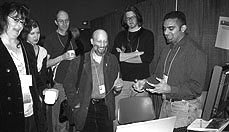Accessibility 2.0: A holistic and user-centred approach to Web accessibility 
Stephen Brown, De Montfort University, United Kingdom
Brian Kelly, UKOLN, United Kingdom
The importance of accessibility to museum Web sites is well-understood. The W3C WAI (Web Accessibility Initiative) guidelines provide a well-recognized and widely accepted approach which can help to ensure that Web resources can be accessed by people with disabilities.
However experiences in use of WAI guidelines since they were released in 1999 is leading organisations to question their effectiveness. It has been argued that the low level of conformance with WAI guidelines is due not to a lack of willingness to provide accessible Web sites but to a realisation that the guidelines have their limitations and the WAI model has its flaws.
Such limitations are becoming even more apparent in a Web 2.0 environment which is providing a range of use case scenarios which were not envisaged when the WAI guidelines were first released.
A new set of guidelines are being developed (WCAG 2.0) which seek to address some of the limitations of the existing guidelines. However, as has been pointed out by Joe Clarke in his "To Hell With WCAG 2.0" article, these guidelines themselves fail to address many of the concerns which have been raised, and have failed to acknowledge that other approaches to accessibility may provide legitimate ways of addressing the challenges of providing accessible solutions. Such limitations, however, do not mean that the guidelines need to be abandoned. Rather there is a need to make use of those guidelines which have been proven to be effective. In addition there is a need to recognize that different contexts may require different solutions.
Such limitations, however, do not mean that the guidelines need to be abandoned. Rather there is a need to make use of those guidelines which have been proven to be effective. In addition there is a need to recognize that different contexts may require different solutions.
In this Professional Forum the facilitators will review the limitations of the WAI approach to accessibility and describe a model for accessibility which emphasizes the importance of addressing user needs holistically rather than simply applying a checklist. An example of a how this approach can be used in a specific context will be given.
The key aspect of the professional forum will be the engagement with the audience. Members of the audience will be invited to:
- Contribute their experiences in providing accessible Web sites and difficulties which may have been experienced.
- Provide feedback on the holistic model.
- Generate the basis of a roadmap to take forward an approach to accessibility which is suited for the requirements of the museum's community.
- Form a working group that takes these issues forward in their respective organisations and countries.
Professional Forum: Accessibility 2.0 [Accessibility]
Keywords: accessibility, usability, interoperability, users, WAI
